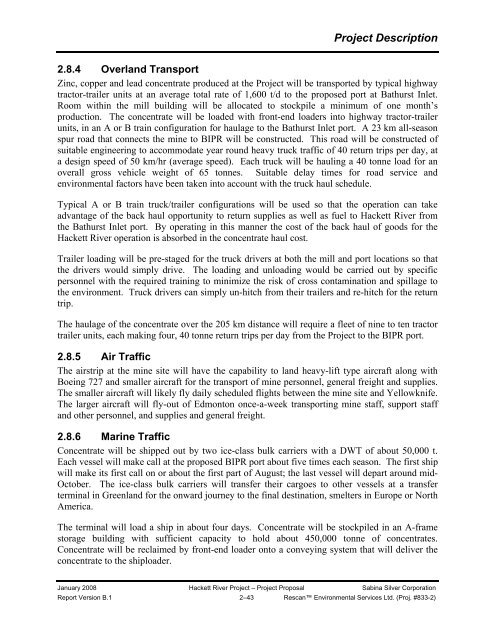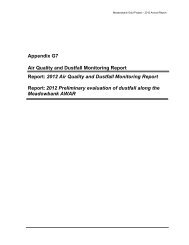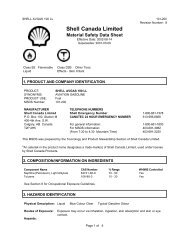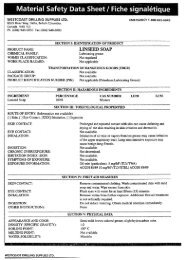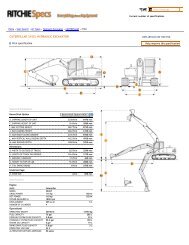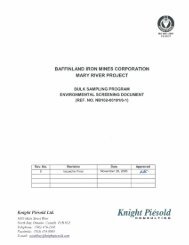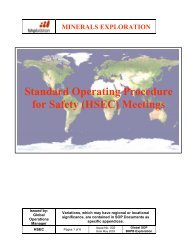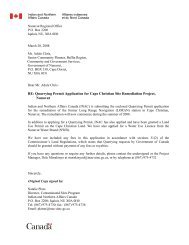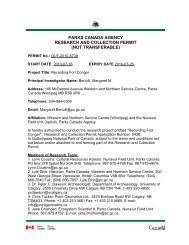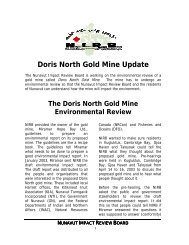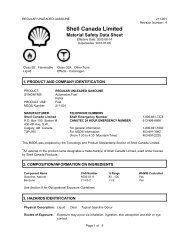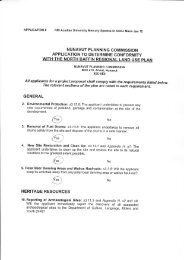080121-08MN006-Sabina Hackett River Project Proposal ... - NIRB
080121-08MN006-Sabina Hackett River Project Proposal ... - NIRB
080121-08MN006-Sabina Hackett River Project Proposal ... - NIRB
Create successful ePaper yourself
Turn your PDF publications into a flip-book with our unique Google optimized e-Paper software.
<strong>Project</strong> Description2.8.4 Overland TransportZinc, copper and lead concentrate produced at the <strong>Project</strong> will be transported by typical highwaytractor-trailer units at an average total rate of 1,600 t/d to the proposed port at Bathurst Inlet.Room within the mill building will be allocated to stockpile a minimum of one month’sproduction. The concentrate will be loaded with front-end loaders into highway tractor-trailerunits, in an A or B train configuration for haulage to the Bathurst Inlet port. A 23 km all-seasonspur road that connects the mine to BIPR will be constructed. This road will be constructed ofsuitable engineering to accommodate year round heavy truck traffic of 40 return trips per day, ata design speed of 50 km/hr (average speed). Each truck will be hauling a 40 tonne load for anoverall gross vehicle weight of 65 tonnes. Suitable delay times for road service andenvironmental factors have been taken into account with the truck haul schedule.Typical A or B train truck/trailer configurations will be used so that the operation can takeadvantage of the back haul opportunity to return supplies as well as fuel to <strong>Hackett</strong> <strong>River</strong> fromthe Bathurst Inlet port. By operating in this manner the cost of the back haul of goods for the<strong>Hackett</strong> <strong>River</strong> operation is absorbed in the concentrate haul cost.Trailer loading will be pre-staged for the truck drivers at both the mill and port locations so thatthe drivers would simply drive. The loading and unloading would be carried out by specificpersonnel with the required training to minimize the risk of cross contamination and spillage tothe environment. Truck drivers can simply un-hitch from their trailers and re-hitch for the returntrip.The haulage of the concentrate over the 205 km distance will require a fleet of nine to ten tractortrailer units, each making four, 40 tonne return trips per day from the <strong>Project</strong> to the BIPR port.2.8.5 Air TrafficThe airstrip at the mine site will have the capability to land heavy-lift type aircraft along withBoeing 727 and smaller aircraft for the transport of mine personnel, general freight and supplies.The smaller aircraft will likely fly daily scheduled flights between the mine site and Yellowknife.The larger aircraft will fly-out of Edmonton once-a-week transporting mine staff, support staffand other personnel, and supplies and general freight.2.8.6 Marine TrafficConcentrate will be shipped out by two ice-class bulk carriers with a DWT of about 50,000 t.Each vessel will make call at the proposed BIPR port about five times each season. The first shipwill make its first call on or about the first part of August; the last vessel will depart around mid-October. The ice-class bulk carriers will transfer their cargoes to other vessels at a transferterminal in Greenland for the onward journey to the final destination, smelters in Europe or NorthAmerica.The terminal will load a ship in about four days. Concentrate will be stockpiled in an A-framestorage building with sufficient capacity to hold about 450,000 tonne of concentrates.Concentrate will be reclaimed by front-end loader onto a conveying system that will deliver theconcentrate to the shiploader.January 2008 <strong>Hackett</strong> <strong>River</strong> <strong>Project</strong> – <strong>Project</strong> <strong>Proposal</strong> <strong>Sabina</strong> Silver CorporationReport Version B.1 2–43 Rescan Environmental Services Ltd. (Proj. #833-2)


